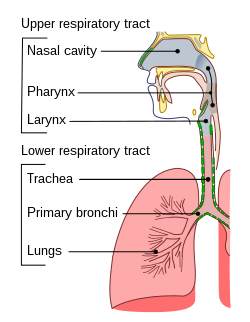Kaman kuol


Kaman kuol, aalso nuo as fresh kuol ar simpli az kuol, a vairal infekshos diziiz a di opa resprichri chrak we praimerili afek di nuoz.[1] Di chruot, sainos, ah vais bax kiah aalso afek.[2] Sain ah simtom kiah bigin les dah tuu die afta expuoja.[2] Deh ingkluud kaafin, suo chuot, ronin nuoz, sniizin, ediek, ah fiiva.[3][4] Piipl yuujali rikova ina sebm tu ten die.[3] Som simtam kiah laas op tu chrii wiik.[5] Demde wid adaels elt prablem maita hokiejanali divelop nyuumuonia.[3]
Wel uoba 200 vairos schrien implikiet ina di kaaz a di kaman kuol; di rainovairosdem a di muos kaman.[6] Deh pred chuu di ier juurin kluos kantak wid infektid piipl ah indirekli chuu kantak wid abjek ina di invairament fala bai chansfor tu di mout ar nuoz.[3] Rix fakta ingkluud wen pitni gaa diekier, smadi naa sliip gud, ah saikalajikal schres.[2] Simtam muosli juu tu di badi uona imyuun rispans tu di infekshan reda dah tu tishu dischrokshan bai di vairos dehself.[7] Piipl wid influenza noftaim shuo simila simtom az piipl wid kuol, duo simtom yuujali muo sivier ina di faama.[2]
No vaxiin no de fi di kaman kuol. Di praimeri metod a privenshan a an washin; no fi toch di yaidem, nuoz ar mout wid anwash an; ah fi tan for frah ada sik piipl.[3] Som evidens supuot di yuus a fies maax.[8] No kyuor fi di kaman kuol egzis, bot di simtomdem kiah chriit.[3] Nansteraidal anti-inflamachri jogz (NSAID) laka aibiupruofen kiah elp wid pien.[9] Antibayatik shuda neba yuuz.[10] Evidens no supuot no benifit frah kaaf medisn.[2]
Di kaman kuol a di muos friikuent infekshos diziiz ina yuuman.[11] Di avrij adolt get tuu tu fuo kuol a ier, wails di avrij pitni maita get six tu iet.[12] Deh okor muo kamanli juurin winta ar wen taim kuol.[3] Demaya infekshan de wid yuumaniti sens ienshent taim.[13]
Refrans
[change up | change up di source]- ↑ Arroll, B (March 2011). "Common cold". Clinical evidence 2011 (3): 1510. PMID 21406124. "Common colds are defined as upper respiratory tract infections that affect the predominantly nasal part of the respiratory mucosa".
- ↑ 2.0 2.1 2.2 2.3 2.4 Allan, GM; Arroll, B (18 February 2014). "Prevention and treatment of the common cold: making sense of the evidence.". CMAJ : Canadian Medical Association 186 (3): 190–9. Template:Citation error. PMID 24468694.
- ↑ 3.0 3.1 3.2 3.3 3.4 3.5 3.6 "Common Colds: Protect Yourself and Others." 6 October 2015. Nuoroda tikrinta 4 February 2016.
- ↑ Eccles R (November 2005). "Understanding the symptoms of the common cold and influenza". Lancet Infect Dis 5 (11): 718–25. Template:Citation error. PMID 16253889.
- ↑ "The common cold". Lancet 361 (9351): 51–9. January 2003. Template:Citation error. PMID 12517470.
- ↑ "Common Cold and Runny Nose." (17 April 2015) Nuoroda tikrinta 4 February 2016.
- ↑ Eccles p. 112
- ↑ Eccles p. 209
- ↑ Kim, SY; Chang, YJ; Cho, HM; Hwang, YW; Moon, YS (21 September 2015). "Non-steroidal anti-inflammatory drugs for the common cold.". The Cochrane database of systematic reviews 9: CD006362. Template:Citation error. PMID 26387658.
- ↑ Harris, AM; Hicks, LA; Qaseem, A; High Value Care Task Force of the American College of Physicians and for the Centers for Disease Control and, Prevention (19 January 2016). "Appropriate Antibiotic Use for Acute Respiratory Tract Infection in Adults: Advice for High-Value Care From the American College of Physicians and the Centers for Disease Control and Prevention.". Annals of Internal Medicine. Template:Citation error. PMID 26785402.
- ↑ Eccles p. 1
- ↑ "Treatment of the common cold". American Family Physician 75 (4): 515–20. 2007. PMID 17323712. http://www.aafp.org/afp/20070215/515.html.
- ↑ Eccles, Ronald; Weber, Olaf (2009). Common cold. Basel: Birkhäuser. p. 3. ISBN 978-3-7643-9894-1. https://books.google.com/books?id=rRIdiGE42IEC&pg=PA3.

